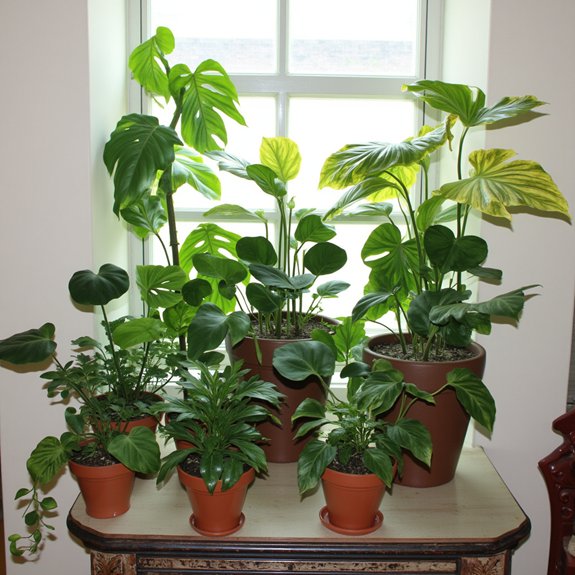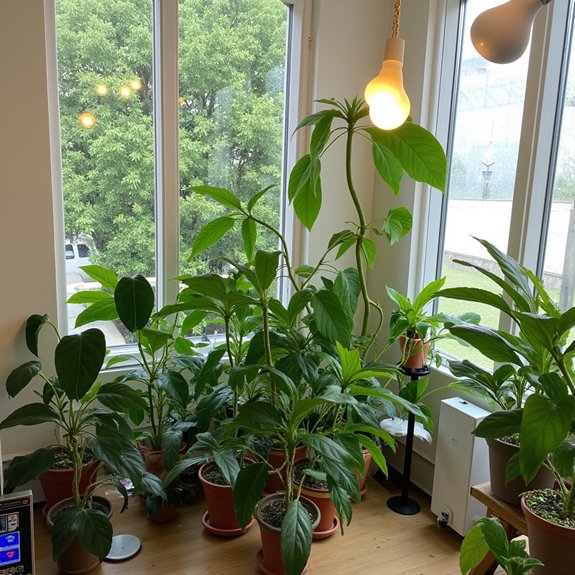Successful Philodendron cultivation transforms ordinary living spaces into lush, tropical sanctuaries when gardeners understand these plants’ specific requirements. These versatile houseplants thrive in controlled indoor environments, but they’ll quickly decline without proper attention to light exposure, watering schedules, and humidity levels. Most indoor gardeners make three critical mistakes during their first year that can permanently damage their plants’ root systems and stunt growth for months.
Contents
- 1 Selecting the Perfect Philodendron Species for Your Home
- 2 Understanding Light Requirements and Placement
- 3 Mastering Proper Watering Techniques
- 4 Essential Feeding and Fertilization Strategies
- 5 Temperature Control and Environmental Conditions
- 6 Pruning and Repotting Best Practices
- 7 Providing Structural Support for Climbing Varieties
- 8 Pest Prevention and Plant Health Management
Selecting the Perfect Philodendron Species for Your Home

Which Philodendron species will thrive in your specific home environment? Understanding species characteristics helps match plants to your space perfectly. Heart-leaf Philodendrons tolerate low light and humidity above 40%, making them beginner-friendly choices.
Meanwhile, Pink Princess varieties need bright indirect light to maintain their stunning variegation. Brasil Philodendrons offer gorgeous golden streaks and adapt well to various conditions. Monstera deliciosa, technically a Philodendron relative, requires more space but creates dramatic indoor statements.
Consider your home’s light levels, humidity, and available space when selecting ideal varieties. Each species brings unique growth habits, so research specific needs before purchasing.
Understanding Light Requirements and Placement
After selecting your perfect species, proper placement becomes the foundation for healthy growth. Philodendrons thrive in bright, indirect sunlight that mimics their natural tropical canopy habitat. Most species tolerate low-light conditions but grow remarkably better with proper light intensity. Place your plant near east or north-facing windows for ideal results, avoiding harsh direct sun that can scorch leaves. South-facing windows work if you position plants three to four feet away from glass. Some lighter-leaved varieties can handle brief morning sun exposure. Remember, adequate lighting directly impacts leaf size, color vibrancy, and overall plant vigor throughout the growing season.
Mastering Proper Watering Techniques

While proper lighting sets the stage for growth, watering technique ultimately determines your philodendron’s health and survival. Check soil moisture by inserting your finger one inch deep into the potting mix. When the top inch feels dry, it’s time to water thoroughly until excess drains from the bottom holes.
Watering frequency depends on humidity, temperature, and pot size. Most philodendrons need water every 7-10 days during growing season, less frequently in winter. Never let plants sit in standing water, as this leads to root rot. Consistent soil moisture monitoring prevents both overwatering disasters and drought stress.
Essential Feeding and Fertilization Strategies
Since philodendrons actively deplete nutrients from their potting mix within months, establishing a consistent feeding routine becomes essential for sustained growth. Understanding nutrient types helps gardeners choose balanced, water-soluble fertilizers containing equal parts nitrogen, phosphorus, and potassium.
Fertilization frequency depends on growing conditions, but most philodendrons thrive with monthly feeding during spring and summer. Apply diluted fertilizer every four to six weeks when plants show active growth. Reduce feeding dramatically during fall and winter months when growth slows.
Monitor your plant’s response carefully. Yellowing leaves often signal nutrient deficiency, while brown leaf tips indicate over-fertilization.
Temperature Control and Environmental Conditions

Creating the right temperature environment for philodendrons requires understanding their tropical origins and maintaining consistent conditions year-round. These plants thrive in temperatures between 65-80°F, mimicking their native habitat perfectly.
Temperature fluctuations stress philodendrons greatly, causing stunted growth and leaf damage. Keep them away from drafts, air conditioning vents, and heating sources that create sudden changes.
Humidity levels complement temperature control beautifully. Aim for 40-60% humidity, using humidifiers or pebble trays during dry seasons. Cold temperatures below 50°F can seriously harm your plant, so monitor conditions carefully during winter months when indoor heating creates challenging environments.
Pruning and Repotting Best Practices
As philodendrons mature and develop their signature lush foliage, regular pruning becomes essential for maintaining their shape and encouraging healthy growth. Effective pruning techniques involve using clean, sharp scissors to remove dead or yellowing leaves during spring or early summer. Cut stems just above a node to promote new growth and prevent disease spread.
Proper repotting timing occurs every 1-2 years when roots emerge from drainage holes or growth becomes stunted. Choose a pot one size larger with adequate drainage, and replace old soil with fresh potting mix to provide essential nutrients for continued development.
Providing Structural Support for Climbing Varieties
While many philodendrons adapt well to hanging baskets, climbing varieties like heartleaf philodendrons and Brasil varieties naturally reach for vertical surfaces in their quest for light. They’ll thrive with proper climbing support structures that mimic their natural habitat.
Moss poles work best, providing both structural stability and moisture retention. Install them when plants reach 12-18 inches tall. Stakes and trellises offer alternative options for budget-conscious gardeners.
Secure vines gently using soft ties, checking monthly for adjustment needs. Well-supported plants develop larger leaves and more vibrant coloration as they climb toward brighter light sources.
Pest Prevention and Plant Health Management
Since philodendrons maintain naturally robust health when their basic needs are met, pest problems typically arise from environmental stress or poor care practices. Regular inspection every week helps catch issues early, focusing on leaf undersides where spider mites and aphids hide.
Effective pest identification techniques include checking for webbing, sticky honeydew, or tiny moving spots. Natural repellents like neem oil work well, applied every two weeks as prevention. Insecticidal soap treats active infestations safely.
Maintaining proper humidity above 40%, adequate airflow, and clean leaves creates an inhospitable environment for pests while supporting your plant’s natural defenses.
